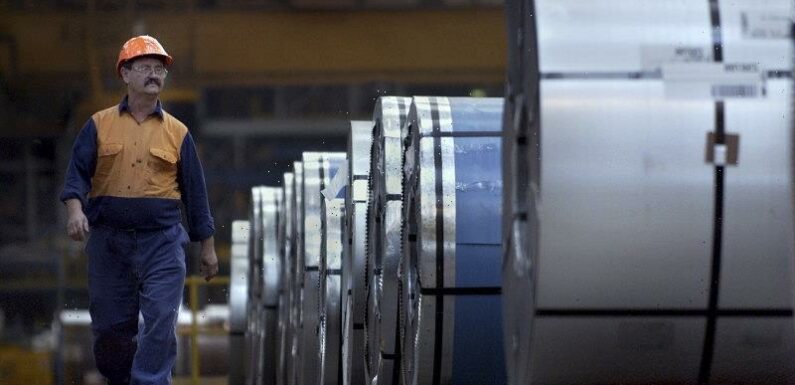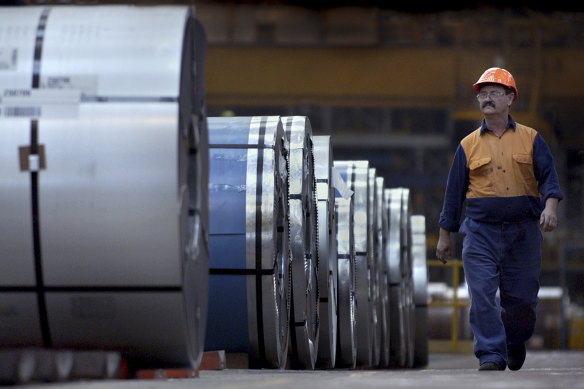
Key points
- Carbon tariffs a key part of EU’s goal to cut emissions by 55 per cent by the year 2030.
- Tariffs will cover sectors such as energy, fertilisers, cement, steel and iron.
- Scheme broadened to include hydrogen and products such as bolts and screws.
London: The European Union has struck a political deal to impose carbon tariffs on imports of polluting goods such as steel and cement, in a world-first scheme which aims to support its domestic industries against those from countries with weak climate laws.
The 27-member bloc last year proposed a law to impose a green levy from 2026 on imports of steel, cement, fertilisers, aluminium and electricity, to prevent domestic industry from being undercut by cheaper goods made in countries with weaker environmental rules.
Finished coils of rolled steel at BlueScope’s Port Kembla steelworks in NSW.Credit:Bloomberg
As part of an all-night sitting of European Parliament measures will now also apply to imported hydrogen, and some downstream products such as screws and bolts and similar articles of iron or steel.
The scheme, known as the carbon border adjustment mechanism, has faced criticism from countries with high-carbon exports including Australia, China, Turkey, India as a protectionist measure, although Brussels has said countries could be exempted if they have a domestic carbon price akin to the EU’s, or similar climate change targets. Europe’s target under the Paris accord is to reduce net greenhouse gas emissions by at least 55 per cent on 1990 levels by 2030.
The measure comes amid heightened trade tensions with the United States over the Inflation Reduction Act’s subsidies for green technologies, which the EU has said could disadvantage European firms.
Brussels argues the new schemeis designed to be in full compliance with World Trade Organisation rules and plans for it to apply from October 1 next year, but with a transition period, where the obligations of the importer shall be limited to reporting.
Before the end of the transition period the European Commission will assess whether to extend the scope to other goods at risk of carbon leakage, including organic chemicals and polymers, with the goal to include all goods covered by the current European emissions trading scheme by 2030. They will also assess the methodology for indirect emissions and the possibility to include more downstream products.
Companies importing goods into the EU will be required to buy certificates to cover their embedded carbon emissions. The scheme is designed to apply the same carbon cost to overseas firms and domestic EU industries – the latter of which are already required to buy permits from the EU carbon market when they pollute.
Mohammed Chahim, European Parliament’s lead negotiator on the law, said the border tariff would be crucial to EU efforts to fight climate change.
“It is one of the only mechanisms we have to incentivise our trading partners to decarbonise their manufacturing industry,” he said. “On top of this, it is an alternative to our current carbon leakage measures, which will allow us to apply the ‘polluter pays’ principle to our own industry. A win-win situation.”
Some details on the law, including its start date, will be determined later this week in related negotiations on a reform of the EU carbon market.
Australian industry has said the country had little to fear in the medium term from implementable border adjustments by the EU because only 0.25 per cent of trade with Europe was affected by the current proposal.
However, the scheme will likely expand and similar schemes in the United States, Japan or other economies could affect much more trade.
Australia’s Department of Foreign Affairs and Trade has said it would examine the EU’s proposal to see whether it is WTO compliant.
The department said it was committed to participating in multilateral discussions that promote trade, build sustainable supply chains and share knowledge.
Charity groups have criticised the EU for introducing the measure without lifting climate funding to developing economies, which will likely be hit hardest by the scheme.
Oxfam EU Tax expert Chiara Putaturo said Europeans were responsible for double the carbon emissions as the poorest half of the world.
“Yet, the EU just agreed to pass the buck to those least responsible by forcing them to pay a tariff despite being hardest hit by the climate crisis. EU countries did not even accept to channel revenues to climate finance funds,” she said.
“The EU and EU countries need to increase climate finance funds, especially now that poor countries are going to bear the cost of the carbon tariff.”
Get a note directly from our foreign correspondents on what’s making headlines around the world. Sign up for the weekly What in the World newsletter here.
Most Viewed in World
From our partners
Source: Read Full Article
